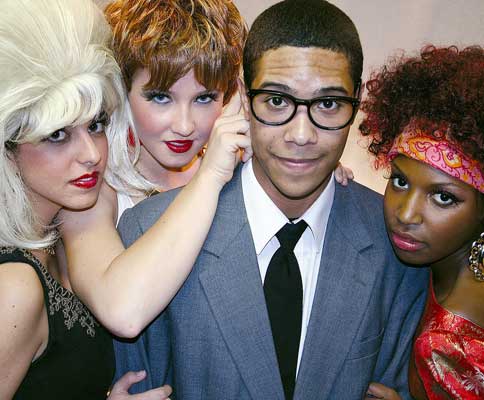
She may work in a dance hall, but Charity Hope Valentine is no prostitute. And despite the sleazy men that have ravished her heart in the past, she still believes in true love.
Complete with beehive wigs and flashy costumes, Sweet Charity is a story about love and loss in a 1960s dance hall told by acting, music and dance.
“To me it’s about a girl who is looking for love and always finds it in all the wrong guys,” Brandy Blackmon, a senior in communication who plays Charity’s best friend Nickie Pignatelli, said. “But then she meets this guy, and he is totally different from every guy she has ever met, dot, dot, dot.”
This new guy Charity meets is Oscar Lindquist, played by Steven Rausch, a senior in international studies and Spanish. Oscar is a nice guy, but has a detrimental fixation with purity.
And Charity, played by Jocelyn Quinn Henderson, a sophomore in biological sciences, may not join some of her friends in the world’s oldest profession, but she is only a few hot, hot degrees away from being an exotic dancer.
Blackmon said getting into her character is difficult because of the complexity of playing an older dance hall veteran.
“High school slutty is different from 35-year-old slutty. They kept telling us, stop being cute,” she said. “They told us to look ‘rode hard and put up wet.'”
But even with such a dark-themed background, the play manages a glittery exterior.
Casey Watkins, a senior in zoology who plays Frenchie, describes the mood as a mix between Austin Powers go-go and Janice Joplin hippie.
“It takes place in the 60s so it’s very mod, very hippie,” she said.
Musical theater productions are notoriously difficult to produce because of all the practical concerns that go along with the flashiness.
“Musicals are very expensive to produce, so we have to take that into consideration,” John McIlwee, director of Sweet Charity , said. “Plus we have to consider the number of students we think we have. That limits a lot of things immediately.”
McIlwee emphasized that musicals are essentially three performances in one: a dance show, a musical show and an acting show. This makes them much more difficult to produce than a drama or comedy.
“In a comedy or a drama you’re just doing lines. While that isn’t easy, it’s a lot easier to put together than a musical,” he said.
Students began practicing continuously at the end of August. Rehearsal began every weeknight at 7 p.m. and lasted until 9 or 10 p.m., creating an intense month for cast members.
Watkins said the hardest part is the schedule because the rehearsals are about four hours a night. But she found that even with an eclectic group of majors, the people she has met still manage good GPAs because they know how to manage their time.
McIlwee also pointed out the benefits their eduction is receiving by being part of a large production.
“They have the time to expand their education in the way being in the arts does, allowing you to visit worlds you normally wouldn’t be able to visit, or enable you to express emotions you may not be able to in real life,” he said. “It enables you to be somebody you wouldn’t be in real life.”